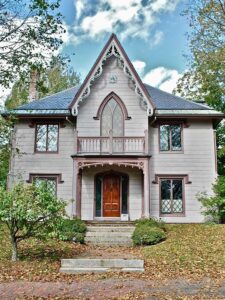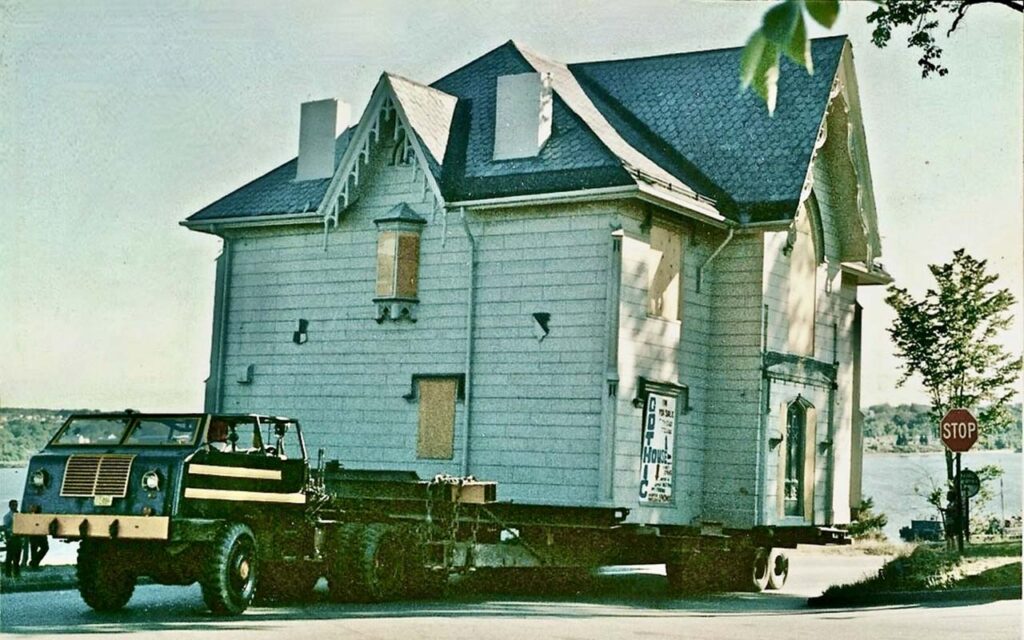The Portland Gothic House & Cuba Connection
Part I
Portland Gothic House Saved from Urban Renewal
By Marta Morse

After purchasing the Portland Gothic House at 387 Spring Street in 1986, I became curious to know more about my new home. This story begins with Portland, Maine’s modernization efforts toward urban renewal.
Urban Renewal Demolitions
During the 1960s and early 1970s the Portland city administration decided to help the city grow by increasing high capacity traffic corridors, thereby supporting demolition of buildings in order to accommodate growing automobile traffic and parking space. Fortunately, passage of the National Historic Preservation Act in 1966 helped slow some of the scheduled demolitions.
Early on, many considered the Spring Street arterial to be an important project. This plan was to connect Spring Street with the newly planned Franklin Arterial. As a condition of sale, Harper Hotels Inc. (developer of the Holiday Inn) insisted on widening Spring Street to four lanes. The historic mansions of Charles Q. Clapp and Maj. Hugh McLellan would remain untouched on the upper side of the block. But existing buildings opposite were destined for demolition.
Sadly, many buildings, like Frye Hall (1917), did not make it. For many years, the Hall and adjacent clubhouse, known as the Woman’s Literary Union Club, had hosted many joyful events. A large Holiday Inn hotel was planned, with plenty of rooms, convention space, swimming pool, and parking. Harper Hotels hoped to lure conventions and tourists to the city.
Preserving Portland’s Historic Architecture
Smarting from the destruction, ten years earlier in 1961, of the Union Station and Clock Tower (built in 1888) on St. John Street, some recognized the need for speedy action. A group of concerned citizens gathered to form an organization toward the preservation of Portland’s remaining historic architecture. The newly formed Greater Portland Landmarks flew into action to save the wooden J. J. Brown House, considered a pristine example of American Gothic Revival, then at 86 Spring Street.
A 1971 application for historic designation was already in progress. Earl G. Shettleworth, Jr. (trustee) and John W Briggs (historian) for Greater Portland Landmarks, Inc. prepared the necessary forms. These efforts soon resulted in the J.J. Brown House being listed on the National Register of Historic Places.
Moving the Gothic House

At that time Mr. and Mrs. Howard B. Whipple owned the building. Assuming that the Whipple’s had been compensated financially by Harper Hotels, Inc., it was not surprising when the management, speeding the planned hotel construction along, passed building ownership to Landmarks for a pittance.
Finding a new plot of land, befitting the newly freed building, became urgent. An open lot was found, luckily still on Spring Street. Number 383 was then the side garden belonging to Joseph and Mary Flagg. Mary related to me, when I became her new neighbor some years later, “It was good to know beforehand what a building looked like, one with no unpleasant surprises.”
Settled now in its new location, the building could be put up for sale.
Expenses for the move had been tallied and a sale would be by closed bid, hopefully covering all accumulated expenditures. Historic designation had been granted before the move, and the new owner would be bound to honor the challenge toward proper restoration in keeping with the original design.
My Part Begins…
In 1986 I became the third owner of the Portland Gothic House and began planning extensive renovations, both exterior and interior. But first, I had to get permission from Greater Portland Landmarks for any exterior physical change. With help from Sam Van Dam, a local architect, we won approval.
We began work to finish the Clifford Street side of the building with an addition. Before the move a porch extended along the back. Removed to simplify transport, those scars were still visible. With Landmarks’ permission, we made a large reflection of the existing bay window into a glass enclosed conservatory. Being 180 degrees opposite its original orientation, the new conservatory now faced westward into a garden. Exterior scraping and painting continued, replacing damaged carved details.
Where History Leads…
I spent much time in the Maine Historical Society library hoping to find further historic details, leading to my surprised introduction to the original inhabitants. What was the story of the owners who built it and why did they build a Gothic style house in wood, replicating stone examples historically familiar in England? Was the original house number 40? When and why was it changed to 86?
Portland has an illustrious past. I was hoping to recapture a sense of pride that the city lost during recent history. My interest was focused. I wanted to discover the original occupants. Was there a story? Curiously, the far off Caribbean Island of Cuba entered the tale.
Part II
Marta’s research uncovers an unexpected connection between the Portland Gothic House and early American shipping trade with the island of Cuba. Read it here.
Marta Morse is a freelance photographer who has shown prints at galleries and diverse venues around the country. She has lived at the Gothic House since 1986.






6 Comments
Deanna Woods
I would very much like to receive more about our History here in Portland. and also i am interested in information need, to maybe become part of what you all are doing? Trees and History are my favorite things to learn about. I have a Big Tree in my front yard. It’s so beautiful and rough around the edges. And the city wants to take it down… because it is too close to wires or cables.
need, to maybe become part of what you all are doing? Trees and History are my favorite things to learn about. I have a Big Tree in my front yard. It’s so beautiful and rough around the edges. And the city wants to take it down… because it is too close to wires or cables.
Thanks for your time
Deanna W.
Tony Zeli
Hello Deanna, thank you for reading. We are interested in covering more local, Portland history and will bring you more on the Gothic House in the coming months. If you would like to learn more about the heritage tree ordinance or recent events around trees in downtown, check out these articles: https://thewestendnews.com/?s=heritage+tree+ordinance
All the best,
Tony Zeli, Publisher & Editor
thewestendnews@gmail.com
Pingback: Scenes of a Portland Family in the Spanish Colony of Cuba - The West End News
Pingback: Markos Miller on Franklin Street: 'Don’t close yourself off to who your allies might be!' - The West End News
Pingback: 19th Century Life in The Portland Gothic House - The West End News
Pingback: Hoping ‘Portland Gothic House’ will directly address slavery - The West End News